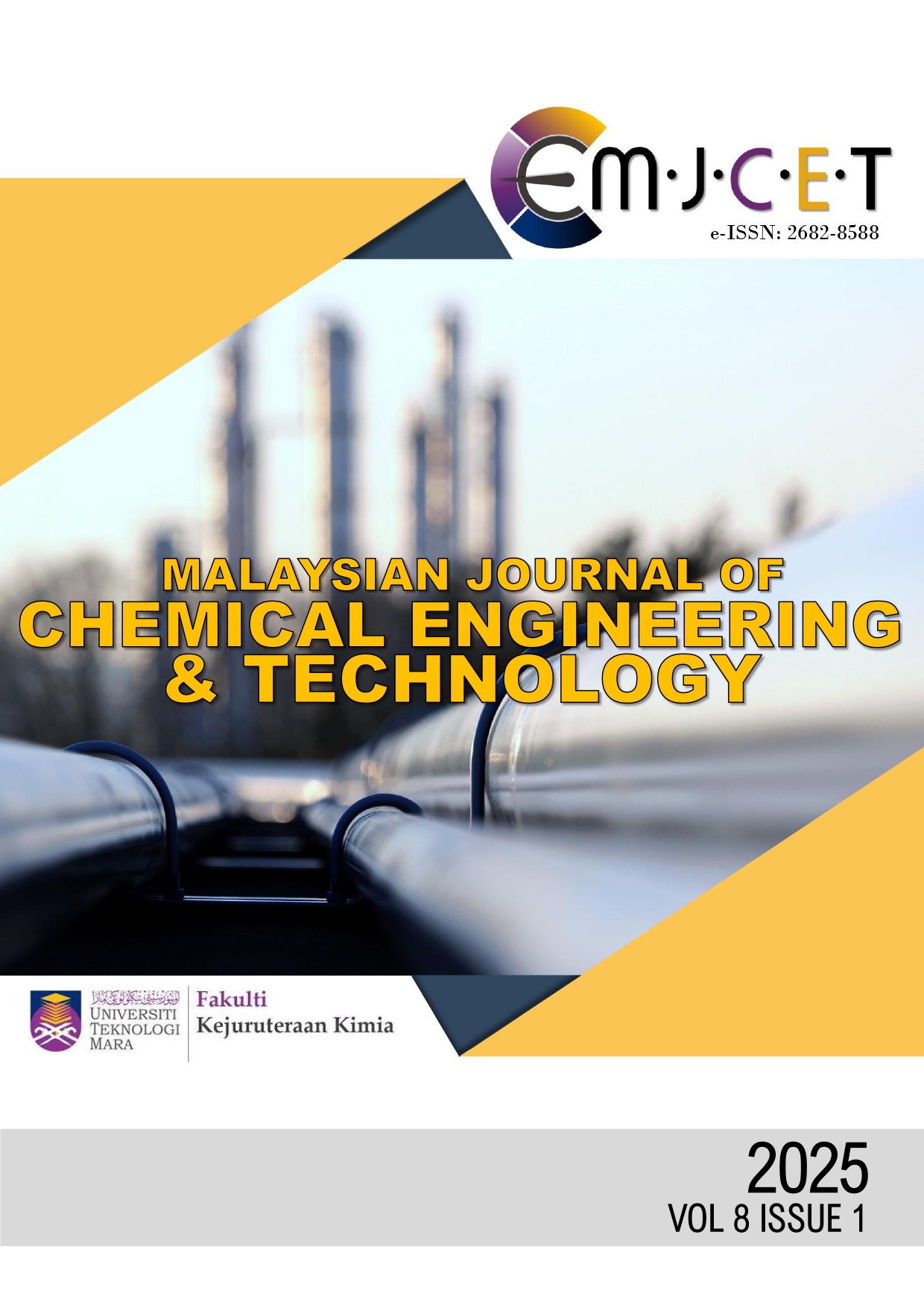Solvent selection for efficient phenolic extraction from palm kernel cake using microwave-assisted techniques
DOI:
https://doi.org/10.24191/mjcet.v8i1.4580Keywords:
Solvent Polarity, Microwave-Assisted Extraction, Phenolic Compound, Palm Kernel Cake, Extraction Yield, Total Phenolic ContentAbstract
This study investigated the recovery of phenolic compounds from palm kernel cake (PKC) using microwave-assisted extraction (MAE),
focusing on the effects of solvent type and liquid-to-solid ratio on extraction efficiency. MAE was performed under constant microwave
power (300 W) and extraction time (25 minutes), while varying the solvent types (ethanol, methanol, and water) and liquid-to-solid ratios (20:1, 30:1, and 40:1). Among the solvents tested, ethanol achieved the highest extraction yield (45%) and total phenolic content (TPC) of 0.086 mg GAE/g dry oil, while water produced the lowest yield (10%) and TPC (0.052 mg GAE/g dry oil). Regarding the liquid-to-solid ratio, the highest extraction yield (48%) was observed at a 40:1 ratio. However, the highest TPC was obtained at a 30:1 ratio, emphasising the dilution effect at higher solvent volumes. These findings demonstrate that optimising both solvent selection and liquid-to-solid ratio is critical for maximising phenolic recovery from PKC. Moreover, the use of ethanol, a food-grade and biodegradable solvent, coupled with MAE technology, provides a sustainable and cost-effective approach for the valorisation of agricultural by-products. The optimised process offers potential applications in the food, nutraceutical, and pharmaceutical
industries.
References
Albuquerque, B. R., Heleno, S. A. 8., Oliveira, M. B. P. P., Barros, L., & Ferreira, I. C. F. R. (2021). Phenolic compounds: Current industrial applications, limitations and future challenges. In Food and Function (Vol. 12, Issue 1, pp. 14–29). Royal Society of Chemistry. https://doi.org/10.1039/d0fo02324h
Awoh, E. T., Kiplagat, J., Kimutai, S. K., & Mecha, A. C. (2023). Current trends in palm oil waste management: A comparative review of Cameroon and Malaysia. In Heliyon (Vol. 9, Issue 11). Elsevier Ltd. https://doi.org/10.1016/j.heliyon.2023.e21410
Carpentieri, S., Soltanipour, F., Ferrari, G., Pataro, G., & Donsì, F. (2021). Emerging green techniques for the extraction of antioxidants from agri-food by-products as promising ingredients for the food industry. In Antioxidants (Vol. 10, Issue 9). MDPI. https://doi.org/10.3390/antiox10091417
Cheok, C. Y., Chin, N. L., Yusof, Y. A., & Law, C. L. (2012). Extraction of Total Phenolic Content from Garcinia mangostana Linn. hull. I. Effects of Solvents and UV-Vis Spectrophotometer Absorbance Method. Food and Bioprocess Technology, 5(7), 2928–2933. https://doi.org/10.1007/s11947-011-0627-2
Djenar, N. S., Mulyono, E. W. S., & Saputra, T. R. (2020). The effect of microwave power variations on phytochemical characteristic of pandan leaves (Pandanus Amaryllifolius) using the Microwave-Assisted Extraction (MAE). Journal of Physics: Conference Series, 1450(1). https://doi.org/10.1088/1742-6596/1450/1/012007
Fabian, F. M. (2012). Application of Response Surface Methodology and Central Application of Response Surface Methodology and Central Composite Design for 5P12-RANTES Expression in the Composite Design for 5P12-RANTES Expression in the Pichia Pichia pastoris pastoris System System. https://digitalcommons.unl.edu/chemengtheseshttps://digitalcommons.unl.edu/chemengtheses/16
Gallo, M., Ferracane, R., Graziani, G., Ritieni, A., & Fogliano, V. (2010). Microwave assisted extraction of phenolic compounds from four different spices. Molecules, 15(9), 6365–6374. https://doi.org/10.3390/molecules15096365
Hashim, M. R., Mohamad, Z., Ngadi, N., Jusoh, Y. M. M., Zakaria, Z. Y., & Jusoh, M. (2020). Microwave-assisted extraction and phytochemical analysis of peperomia pellucida for treatment of dengue. Chemical Engineering Transactions, 78, 409–414. https://doi.org/10.3303/CET2078069
Jasiukaitytė-Grojzdek, E., Huš, M., Grilc, M., & Likozar, B. (2020). Acid-catalysed α-O-4 aryl-ether bond cleavage in methanol/(aqueous) ethanol: understanding depolymerisation of a lignin model compound during organosolv pretreatment. Scientific Reports, 10(1). https://doi.org/10.1038/s41598-020-67787-9
Kua, S. F., Ibrahim, J., Ooi, C. K. W., Nan, K. I., Hashim, N., & Mohd Yusof, H. (2015). Optimisation of phenolic extraction and quantification of phenolics in palm kernel cake. Renewable Bioresources, 3(1), 2. https://doi.org/10.7243/2052-6237-3-2
Mahlia, T. M. I., Ismail, N., Hossain, N., Silitonga, A. S., & Shamsuddin, A. H. (2019). Palm oil and its wastes as bioenergy sources: a comprehensive review. In Environmental Science and Pollution Research (Vol. 26, Issue 15, pp. 14849–14866). Springer. https://doi.org/10.1007/s11356-019-04563-x
Ni’Mah, L., Setiawan, M. F., & Prabowo, S. P. (2019). Utilization of Waste Palm Kernel Shells and Empty Palm Oil Bunches as Raw Material Production of Liquid Smoke. IOP Conference Series: Earth and Environmental Science, 366(1). https://doi.org/10.1088/1755-1315/366/1/012032
Ofori-Boateng, C., & Lee, K. T. (2013). Sustainable utilization of oil palm wastes for bioactive phytochemicals for the benefit of the oil palm and nutraceutical industries. Phytochemistry Reviews, 12, 173-190.
Onoji, S. E., Iyuke, S. E., Igbafe, A. I., & Daramola, M. O. (2019). Hevea brasiliensis (rubber seed) oil: modeling and optimization of extraction process parameters using response surface methodology and artificial neural network techniques. Biofuels, 10(6), 677–691. https://doi.org/10.1080/17597269.2017.1338122
Osorio-Tobón, J. F. (2020). Recent advances and comparisons of conventional and alternative extraction techniques of phenolic compounds. Journal of Food Science and Technology, 57, 4299-4315.
Rezaei, S., Rezaei, K., Haghighi, M., & Labbafi, M. (2013). Solvent and solvent to sample ratio as main parameters in the microwave-assisted extraction of polyphenolic compounds from apple pomace. Food Science and Biotechnology, 22(5), 1–6. https://doi.org/10.1007/s10068-013-0212-8
Saifuddin, N. M., Uskenbayeva, S., & Ong, M. Y. (2018). On increase of the efficiency of extracting phenolic compounds from palm oil mill effluent Development of Bio-Hydrogen Production From Algae : A Review View project adsorption and waste water treatment View project References 3. https://www.researchgate.net/publication/322674594
Tungchaisin, T., Sae-Tan, S., & Rattanaporn, K. (2022). Optimization of Microwave-Assisted Extraction of Palm Kernel Cake Protein. E3S Web of Conferences, 355, 02018. https://doi.org/10.1051/e3sconf/202235502018
Widyawati, P. (2014). Difference of solvent polarity to phytochemical content and antioxidant activity of Pluchea indicia less leaves extracts. Repository.Wima.Ac.Id. http://repository.wima.ac.id/id/eprint/10684/
Downloads
Published
How to Cite
Issue
Section
License
Copyright (c) 2025 Ellisa Natasya Rosli, Norhusna Mohamad Nor, Siti Hawa Mat Yaman

This work is licensed under a Creative Commons Attribution-ShareAlike 4.0 International License.










